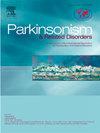The impact of cognitive impairment and Alzheimer's disease neuropathological changes on gait, freezing and falls in Parkinson's disease
IF 3.1
3区 医学
Q2 CLINICAL NEUROLOGY
引用次数: 0
Abstract
Background
The longitudinal impact of cognitive impairment and Alzheimer's disease neuropathological changes (ADNC) on gait dysfunction in Parkinson's disease (PD) requires further evaluation. This study aimed to investigate the association between cognitive impairment and ADNC on gait disturbances in PD.
Methods
Retrospective cohort study of pathology-confirmed PD patients with brain donation to the Queen Square Brain Bank between 2010 and 2022. Cognitive parameters (latency to dementia, hallucinations, and cholinesterase inhibitors prescription) and gait outcomes (falls, freezing (FoG), wheelchair use, postural instability and gait difficulty subtype (PIGD)) were collected from medical records. Lewy pathology and ADNC were assessed using standard staging systems. Cox proportional and logistic regression analyses estimated the associated risk of cognitive parameters and pathological changes with gait outcomes.
Results
A total of 140 PD patients (mean onset 60.7 years) were included. Dementia increased risk of future falls (Hazard Ratio (HR) 0.88; 95 %CI 0.84–0.92), wheelchair dependence (HR 0.84; 95 %CI 0.78–0.89), FoG severity (Odds Ratio(OR) 0.88; 95 %CI 0.77–0.98) and the PIGD subtype (OR 0.80; 95 %CI 0.69–0.92). Hallucinations increased FoG risk (HR 0.95; 95 %CI 0.92–0.99) and the PIGD subtype (OR 0.86; 95 %CI 0.75–0.97). Global ADNC and amyloid-β deposition were associated with earlier (HR 5.17; 95 %CI 1.50–17.78) and more severe gait freezing (OR 2.13; 95 %CI 1.25–3.62).
Conclusion
Cognitive impairment and hallucinations are risk factors for future gait disturbances and FoG in PD. Global ADNC (particularly amyloid-β deposition) likely contribute to the pathophysiology of FoG, with potential therapeutic implications.
求助全文
约1分钟内获得全文
求助全文
来源期刊

Parkinsonism & related disorders
医学-临床神经学
CiteScore
6.20
自引率
4.90%
发文量
292
审稿时长
39 days
期刊介绍:
Parkinsonism & Related Disorders publishes the results of basic and clinical research contributing to the understanding, diagnosis and treatment of all neurodegenerative syndromes in which Parkinsonism, Essential Tremor or related movement disorders may be a feature. Regular features will include: Review Articles, Point of View articles, Full-length Articles, Short Communications, Case Reports and Letter to the Editor.
 求助内容:
求助内容: 应助结果提醒方式:
应助结果提醒方式:


